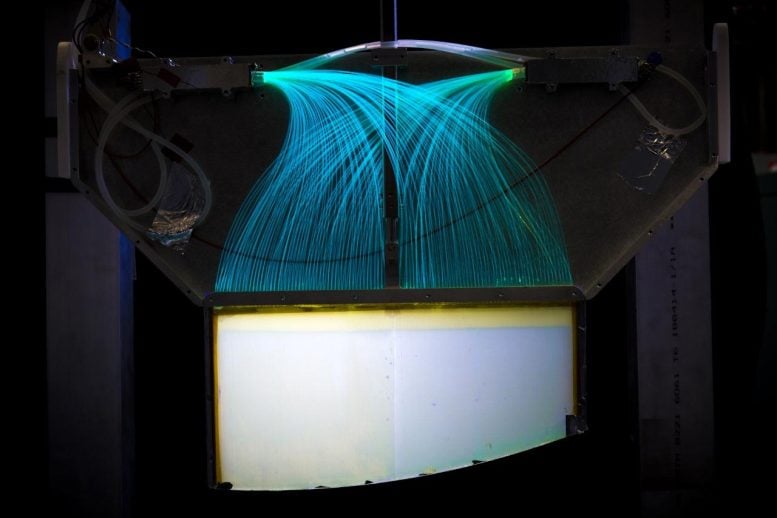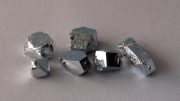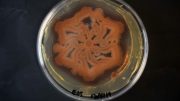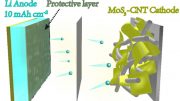
The high-efficiency ultracold neutron detector employed in the “bathtub” trap. Credit: Los Alamos National Lab / Michael Pierce
An international team of researchers has made the world’s most precise measurement of the neutron’s lifetime, which may help answer questions about the early universe.
An international team of physicists led by researchers at Indiana University Bloomington has announced the world’s most precise measurement of the neutron’s lifetime.
The results from the team, which encompasses scientists from over 10 national labs and universities in the United States and abroad, represent a more than two-fold improvement over previous measurements — with an uncertainty of less than one-tenth of a percent.
The work is reported in the October 13, 2021, issue of the journal Physical Review Letters. It was also the subject of a live news briefing at the 2021 Fall Meeting of the American Physical Society Division of Nuclear Physics.
“This work sets a new gold-standard for a measurement that has fundamental importance to such questions as the relative abundances of the elements created in the early universe,” said David Baxter, chair of the IU Bloomington College of Arts and Sciences’ Department of Physics. “We’re proud of IU’s long-time role as a leading institution on this work.”
IU-affiliated authors at the time of the study were graduate students Nathan Callahan, Maria Dawid and Francisco Gonzalez; engineer Walt Fox; Rudy Professor of Physics Chen-Yu Liu; research scientist Daniel Salvat; and mechanical technician John Vanderwerp. (Callahan and Gonzalez are currently affiliated with Argonne National Laboratory and Oak Ridge National Laboratory, respectively.) The research was conducted at Los Alamos National Laboratory.
The scientific purpose of the experiment is to measure how long, on average, a free neutron lives outside the confines of atomic nuclei.
“The process by which a neutron ‘decays’ into a proton — with an emission of a light electron and an almost massless neutrino — is one of the most fascinating processes known to physicists,” said Salvat, who led the experiments at Los Alamos. “The effort to measure this value very precisely is significant because understanding the precise lifetime of the neutron can shed light on how the universe developed — as well as allow physicists to discover flaws in our model of the subatomic universe that we know exist but nobody has yet been able to find.”
The neutrons used in the study are produced by the Los Alamos Neutron Science Center Ultracold Neutron source at Los Alamos National Lab. The UCNtau experiment captures these neutrons, whose temperatures are lowered to nearly absolute zero, inside a “bathtub” lined with about 4,000 magnets. After waiting 30 to 90 minutes, researchers count the surviving neutrons in the tub as they’re levitated against gravity by the force of the magnets.
The unique design of the UCNtau trap allows neutrons to remain stored for more than 11 days, a significantly longer time than earlier designs, minimizing the need for systematic corrections that could skew the results of the lifetime measurements. Over two years, the study’s researchers counted approximately 40 million neutrons captured using this method. These efforts were the thesis work of Gonzalez, who collected the data at Los Alamos as an IU graduate student from 2017 to 2019, and led the analysis of the published result.
Salvat said the experiment’s results will help physicists confirm or deny the validity of the “Cabibbo-Kobayashi-Maskawa matrix,” which concerns subatomic particles called quarks and plays an important role in the widely accepted “standard model” of particle physics. It will also help physicists understand the potential role that new ideas in physics, such as neutrons decaying into dark matter, may play in evolving theories about the universe, as well as possibly help explain how the first atomic nuclei were formed.
“The underlying model explaining neutron decay involves the quarks changing their identities, but recently improved calculations suggest this process may not occur as previously predicted,” Salvat said. “Our new measurement of the neutron lifetime will provide an independent assessment to settle this issue, or provide much-searched-for evidence for the discovery of new physics.”
Reference: “Improved neutron lifetime measurement with UCNτ” by F. M. Gonzalez, E. M. Fries, C. Cude-Woods, T. Bailey, M. Blatnik, L. J. Broussard, N. B. Callahan, J. H. Choi, S. M. Clayton, S. A. Currie, M. Dawid, E. B. Dees, B. W. Filippone, W. Fox, P. Geltenbort, E. George, L. Hayen, K. P. Hickerson, M. A. Hoffbauer, K. Hoffman, A. T. Holley, T. M. Ito, A. Komives, C.-Y. Liu, M. Makela, C. L. Morris, R. Musedinovic, C. O’Shaughnessy, R. W. Pattie Jr., J. Ramsey, D. J. Salvat, A. Saunders, E. I. Sharapov, S. Slutsky, V. Su, X. Sun, C. Swank, Z. Tang, W. Uhrich, J. Vanderwerp, P. Walstrom, Z. Wang, W. Wei and A. R. Young (UCNτ Collaboration), 13 October 2021, Physical Review Letters.
arXiv: 2106.10375
DOI: 10.1103/PhysRevLett.127.162501









So, what was the result? Everyone is reporting a new measurement, how it was done, nobody is reporting what that measurement was. Should I ask the Magic 8-Ball? If you aren’t going to report what the measurement was, why report it at all? There were probably over a hundred million measurements made today, why don’t you have an article for each of them? Useless information seems to intrigue your readers, and I can’t think of anything more useless than reporting that there was a measurement without reporting the actual measurement.
I too am equally upset about how ridiculous this article is to not talk about any actual results.
Just trust the science
The title indicated the “Most Precise Measurement of Neutron Lifetime”. However, the article never mentions the result of the measurement. How long is the new lifetime of neutrons? The title promises this knowledge but the article does not deliver.
According to other sources, the result was 877.75 ± 0.28 seconds (14 minutes and 38 seconds).
Buried in the text we see “…how long, on average, a free neutron lives…” But nothing else in the article would help the reader develop a basic understanding that the nature of quantum processes requires the use of statstics in understanding our universe., and that this search was for the properties of a distribution rather than just a ‘number’.
We seek to advance STEM within our education system, but to do so we must communicate the concepts and harness the curiosity thus engendered. Science news for the public could be be more than “gee whiz”.
It’s a variant of the tragedy of the commons – press releases has to appeal foremost to the experts and the grant services hiring them. They know that this is distributions. Of course, you could wish for them being more easy reads for the tax paying, curious public.
I think that you are alluding to are popular science articles, which is a completely different genre. It is easy to see the difference in most cases, press releases most often (not always) have an institution (its press agency) as author, articles have individuals as authors.
*what you are alluding to.
A teachable moment was missed. Is a neutron’s lifetime a constant or a distribution who’s mean or standard deviation was measured? Does its lifetime depend on temperature or location? May I please have a taste of the postulated quark processes involved?
I do like a little SciTech with breakfast, but this morning’s mind snack was empty calories!
Thank you Richard Bennett and steveh64 for both of your clearly stated comments.
Besides not mentioning the actual measurement result, the significant discrepancy between the bottle method (as they have used) and the beam method is not mentioned.
That too is discussed in the paper. (It would be hard not to give the context.)
“Studies of neutron decay, with increasing precision, are becoming a theoretically and experimentally robust standard model test [7, 8].
The current puzzle [9] due to the discrepancy between “beam” [10] and “bottle” [11–16] methods of τn measurement indicates either the existence of new physics leading to a neutron decay channel without protons in the final state or the presence of inadequately assessed or unidentified systematic effects in either of the techniques. The former could be induced by the decay of neutrons to dark-matter particles [17], though such theories are constrained by astrophysical and cosmological signatures [18–21] and by direct searches for specific decay signatures [22, 23]. Meanwhile, novel space-based and neutron-beam-based techniques aim to provide complementary τn measurements [24? –26]. This motivates a blinded measurement of τn with high statistical precision with multiple independent assessments of systematic effects and uncertainties.”
It behooves everyone to read the paper before commenting on the science.
This text was a press release from the AMERICAN PHYSICAL SOCIETY, which purpose is to entice scientists and other interested to read the paper. Which was helpfully linked, even today not all press releases do that.
The lifetime is in the abstract, just one click away:
“We report an improved measurement of the free neutron lifetime τ_n using the UCNτ apparatus at the Los Alamos Neutron Science Center. We count a total of approximately 38×10^6 surviving ultracold neutrons (UCN) after storing in UCNτ ’s magneto-gravitational trap over two data acquisition campaigns in 2017 and 2018. We extract τ_n from three blinded, independent analyses by both pairing long and short storage-time runs to find a set of replicate τn measurements and by performing a global likelihood fit to all data while self-consistently incorporating the β-decay lifetime. Both techniques achieve consistent results and find a value τ_n = 877.75 ± 0.28_stat + 0.22/ − 0.16_syst s. With this sensitivity, neutron lifetime experiments now directly address the impact of recent refinements in our understanding of the standard model for neutron decay.”
So the final free neutron lifetime is ~ 978 s. And the precision is 4 digits. And that’s not according to *this* source – if you read it.
*That’s according to *this* source – if you read it.
If I would wish for anything of science sites is to have a “How to” read their sites. Clearly lay our what articles are and what press releases are, and describe their differences in aim and language.
And ask readers to click through to the science – what they want to know is most often in the paper abstract.
I agree with Captain Obvious. Why don’t you share the results in this article?
Suppose there was an event ejecting neutrons from Earth’s sun. Even if the neutrons traveled at the speed of light it would take more than 15 minutes to reach earth, so assuming a symmetric distribution, more than half the neutrons will have converted to ____?
And would that be better or worse than the original neutrons for life on earth?
Wikipedia article: Free neutron decay
Explains bottle and beam methods as well as theoretical prediction.
https://en.wikipedia.org/wiki/Free_neutron_decay
So what does the value “value τn=877.75±0.28” mean in lay terms? Years? Epochs?
Both techniques achieve consistent results and find a value τn=877.75±0.28 stat+0.22/−0.16 syst~s. With this sensitivity, neutron lifetime experiments now directly address the impact of recent refinements in our understanding of the standard model for neutron decay.
Very Interesting Work. Somethoughts triggerred.
1. Can we build a cheaper and more modern Neutron Source in Intersteller Space where temperatures are around 3 degrees kelvin with fewer magnets and at a much more economical cost?
2.This three year effort to determine the lifetime of Neutron decay could be done in a much faster timeframe with UCNTau trap redesigned for Deep Space Environment? Additional experiments to understand the quantum processes can also be carried out.
3. From a Science Point of View , have always been fascinated about the Possibility of Fusion at Room temperature and a cheap inexhaustible source of power from subatomic particles which can be carried out at near earth temperatures of around 10 degrees celsius i.e 283.2 degrees Kelvin. These experiments, if carried out in Space could give us clues on how to get to “Cold Fusion” at room temperature (at least in Places like Alaska, Canada and the Artic and Siberia), and under what conditions such fusion can be enabled on the planet or its sattelites natural or artificial.
Views expressed are not binding on anyone.